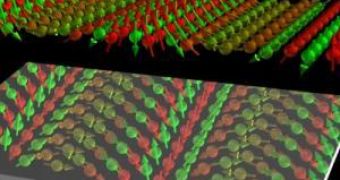A recent discovery shows that nature can easily make the difference between the image and the mirror image of magnetic structures, on a nanoscale level.
Physicists from Research Centre J?lich and the University of Hamburg have used both experimental work and computer simulations to detect a "homochiral" magnetic structure in a thin layer of metal.
Surprisingly, a mirror-image version of the particles' spin could never exist in reality, so nature is being very selective when it comes to magnetism on the subatomic level.
Homochirality refers to a group of molecules that have the same chirality, which means similar groups have the same arrangement around a central atom, even if the molecules involved don't necessarily have the same composition.
Structures and arrangements that can't be superimposed on their mirror-image are called "chiral" and an example of this asymmetry is the human hand.
The scientists think this could lead the way into a completely new research area, as well as being very useful to applications in "spintronics," a technological field which exploits the quantum spin states of electrons as well as making use of their charge state.
They calculated that in a single atomic layer of manganese it is always the same three-dimensional, rotated arrangement that occurs and never the mirror image, and they eventually confirmed these calculations in laboratory experiments.
The importance of this find has been stressed out by Prof. Stefan Bl?gel, Director at the J?lich Institute of Solid State Research: "Such chiral structures are hot candidates for practical applications, for example in the promising field of 'spintronics', since they permit a coupling of electronic, optical, magnetic and structural properties. In the components of the future, the flowing current can transfer spin moment to the magnetic structure and thus set it in motion."
Future advances may allow significant improvements of the current information technologies. "Understanding and controlling the twists and turns of thin-film magnetic states could well be handy for new applications such as ultra-high-density magnetic recording media."

 14 DAY TRIAL //
14 DAY TRIAL //